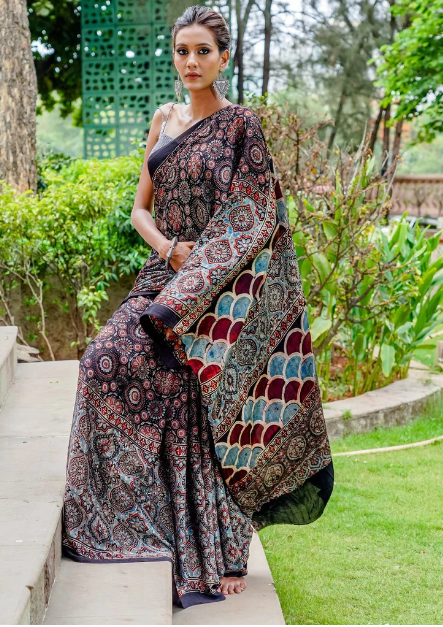Choose another country or store view to see content specific to your location and shop online.
40 Types of Sarees: Celebrating the Vibrant Mosaic of Indian Textiles
40 Types of Sarees: Celebrating the Vibrant Mosaic of Indian Textiles |Jan 16, 2024
- Share
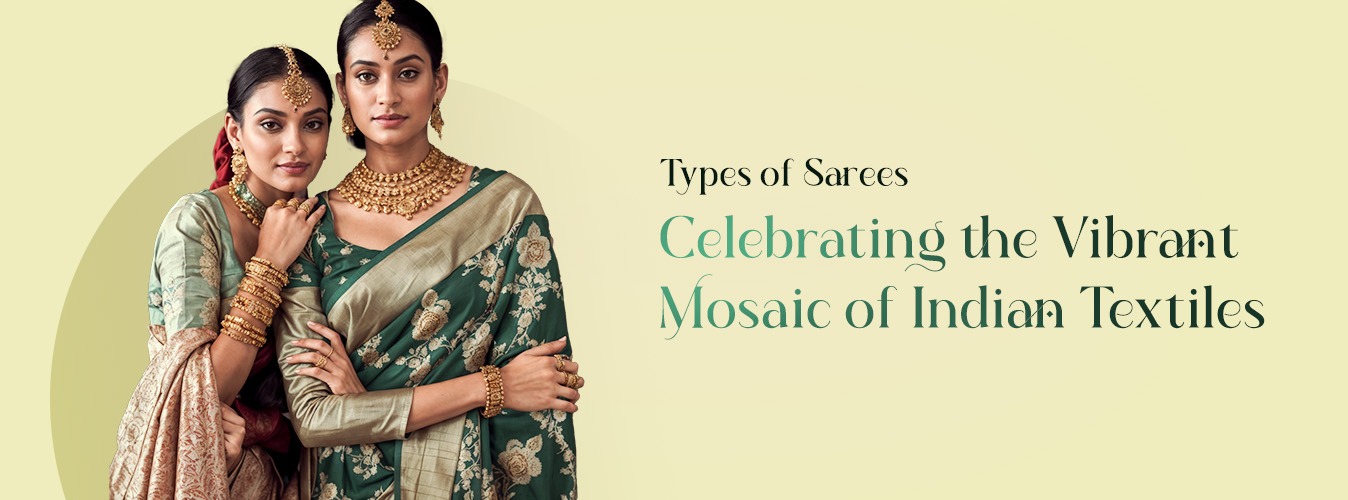
With their origins dating back thousands of years, sarees have evolved into a symbol of grace, femininity, and enduring style. Every thread whispers tales of tradition, where colours dance in vibrance and patterns weave stories of heritage. From the regal Banarasis to the playful Bandhanis, each loom tells a story of craftsmanship, heritage, and timeless beauty. Join us as we delve into the rich tapestry of Indian textiles, exploring the nuances and intricacies that make each saree a masterpiece in its own right. Sarees are more than just fabric; they’re a celebration of the rich tapestry that defines the heart and soul of Indian handiwork. Let's unravel the threads that bind tradition and style and celebrate the elegance that drapes the Indian woman in a symphony of poise and sophistication. Bandhani Sarees are traditional Indian sarees known for their vibrant colours and distinctive tie-dye patterns. The Sanskrit word "bandhna," meaning to tie, gives rise to the word "bandhani." The western states of India, particularly Gujarat and Rajasthan, are the origin of these sarees, which are highly valued for their intricate craftsmanship. Pic Courtesy: Pinterest All women, despite their modern tastes, have a soft spot for the exceptional quality, luxurious texture, and exquisite finesse of the Mysore sarees. Women highly covet these sarees for their softness, durability, and the refined silk used. Mysore Silk Sarees are often considered a symbol of elegance and grace in Indian traditional attire. Kalamkari Sarees are traditional Indian sarees known for their beautiful hand-painted or block-printed designs. It involves the use of natural dyes derived from plants, minerals, and other organic sources. Banarasi Sarees are the timeless epitome of elegance, adorned with intricate zari work and opulent silk. Renowned for their rich heritage, these sarees draw you in with their luxurious feel, vibrant colours, and exquisite brocade patterns. Pic Courtesy: Pinterest Muga Silk Sarees emanate timeless allure with their golden luster and exceptional smoothness. Woven from the rare Muga silk, sourced exclusively from Assam, these sarees boast intricate traditional motifs. Pic Courtesy: Pinterest Pic Courtesy: Pinterest Pic Courtesy: Pinterest Kanchipuram Sarees, Renowned for their rich texture and opulent motifs inspired by temple architecture, these sarees effortlessly blend tradition and sophistication, making every drape a symbol of cultural grandeur and enduring beauty. Pic Courtesy: Pinterest Pic Courtesy: Pinterest Pic Courtesy: Pinterest Paithani Sarees, known for their luxurious zari borders, these sarees exude timeless elegance and cultural richness. Paithani sarees are a visual delight with their vibrant silk fabric adorned with intricate Pic Courtesy: Pinterest Pic Courtesy: Pinterest The artisans meticulously stitch small pieces of zari and silk onto the fabric to create delicate gotta patti work on these sarees. Gotta Patti Sarees are a popular choice for weddings and festive occasions. Pic Courtesy: Pinterest Pic Courtesy: Pinterest Crafted from a blend of silk and cotton, these sarees are very popular for their lightweight texture and luxuriant feel. Chanderi Sarees often feature a unique border and pallu that express the art of traditional weavers. Known for their soft texture and comfort, Mashru sarees feature silk on the upper side and cotton on the underside. They exhibit brighter colours and geometric patterns. Get Plain Mashru Silk Fabric and Mashru Printed Fabric from Mysore Saree Udyog. The sheer muslin or cotton texture of Jamdani sarees adds to their elegance, making them airy and wearable. Jamdani Sarees are favoured for their sheer grace and versatility, suitable for both formal events and casual wear. Pic Courtesy: Pinterest The hand-woven artisanship and the use of cheeky colours add to the timeless beauty of Venkatagiri Sarees. Crafted predominantly from lightweight cotton or silk, these sarees boast a fine texture and delicate zari work. Pic Courtesy: Pinterest Pic Courtesy: Pinterest Pic Courtesy: Pinterest Pic Courtesy: Pinterest Pic Courtesy: Pinterest Pic Courtesy: Pinterest Pic Courtesy: Pinterest Pic Courtesy: Pinterest Pic Courtesy: Pinterest Pic Courtesy: Pinterest Pic Courtesy: Pinterest Pic Courtesy: Pinterest Pic Courtesy: Pinterest Pic Courtesy: Pinterest Pic Courtesy: Pinterest Ikkal sarees are known for their distinctive and elaborate geometric patterns. They are traditionally woven in cotton or silk, and the unique feature of these sarees is the resist-dyeing technique used to create intricate designs. The pallu is very often embellished with bold and contrasting patterns. Pic Courtesy: Pinterest Tune into the world of grace—shop your favourites from our authentic collection of traditional Indian sarees from artisans around the nation. Visit the online or offline store of Mysore Saree Udyog today and plump for what suits you the best. Flaunt your style with pride while staying true to tradition.
Types of Sarees by Indian Origin1. Bandhani Sarees from Rajasthan and Gujarat
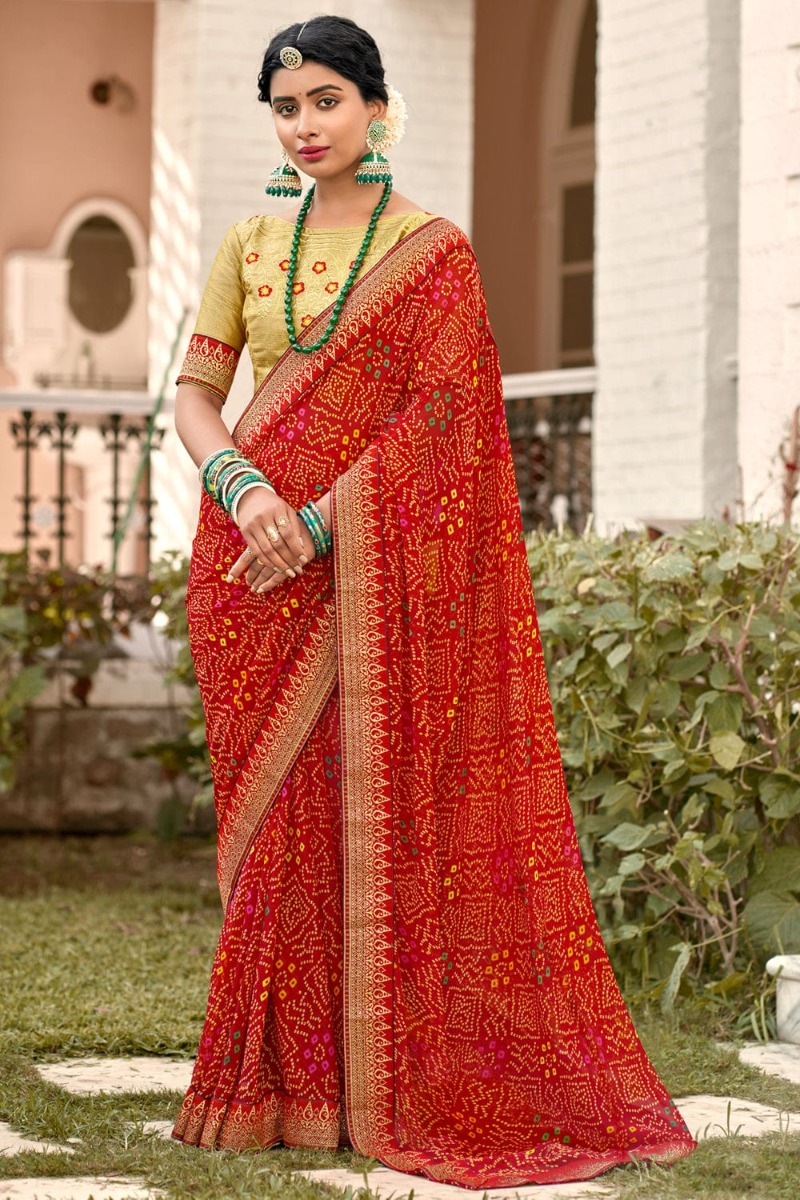
2. Mysore Silk Sarees from Karnataka

3. Kalamkari Sarees from Andhra Pradesh

Pic Courtesy: Pinterest
4. Banarasi Saree from Varanasi
5. Muga Silk Saree from Assam

6. Leheriya Saree from Rajasthan
Leheriya sarees charm with their vibrant tie-dye patterns, reminiscent of rippling waves. The vivid hues and rhythmic designs make leheriya sarees a lively and festive choice, perfect for celebrating tradition with a modern flair.
7. Phulkari Saree from Punjab
Originating from the heart of Punjab, Phulkari sarees do not ever fail to enrapture you with their exuberant and intricate floral embroidery. Its beauty lies in the meticulous artisanship and lively patterns that add a burst of tradition and joy to every Phulkari saree, making it a cultural treasure.
8. Kanchipuram Sarees from Tamil Nadu

9. Nauvari Saree from Maharashtra
Nauvari sarees exude timeless elegance with their unique nine-yard drape, distinctive pleats, and traditional Maharashtrian style. The vibrant colours, intricate borders, and rich fabric showcase a perfect blend of cultural heritage and contemporary grace.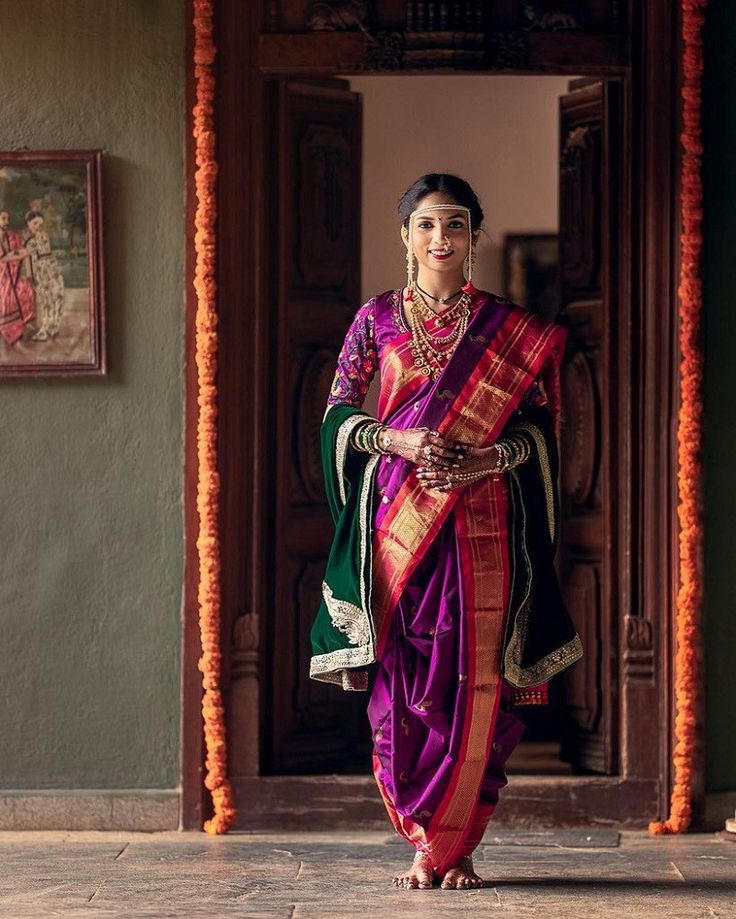
10. Sambalpuri Saree from Odisha
These sarees feature elaborate ikat patterns and vibrant hues. The meticulous tie-and-dye technique creates a symphony of colours, and the traditional motifs narrate stories of Odisha's rich culture.
11. Ajrakh Sarees from Gujarat
The symmetrical patterns and earthy tones create a visual appeal that reflects the cultural heritage of Gujarat and Rajasthan. Ajrakh sarees are a masterpiece of textile artistry, renowned for their intricate block printing and rich natural dyeing techniques.Pic Courtesy: Pinterest
12. Paithani Saree from Maharashtra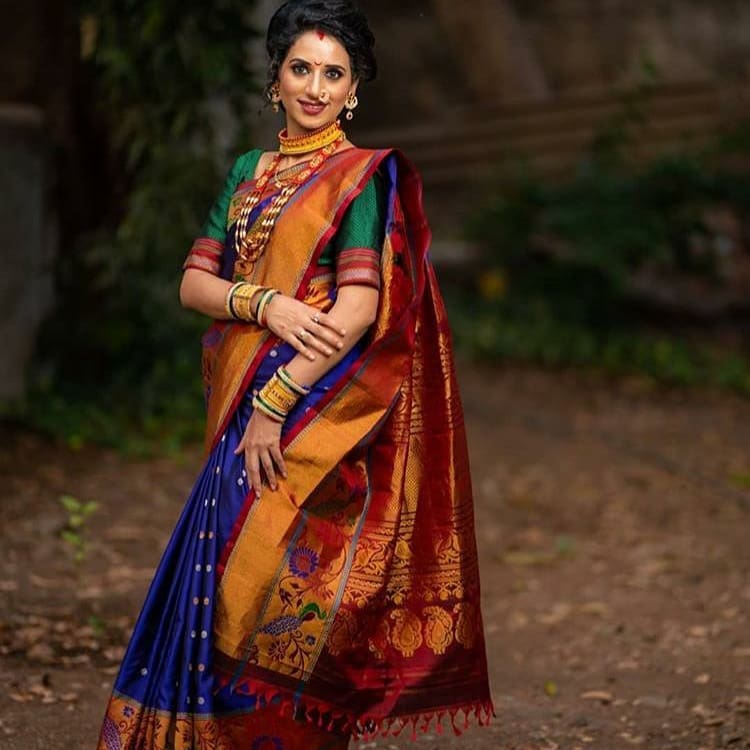
13. Tussar Silk Sarees from Bengal
The exquisite threads of wild silk, created by silkworms found in Indian forests, are used to make Tussar Sarees. Characterised by a rich, golden sheen and often adorned with intricate hand-woven designs, Tussar Silk Sarees effortlessly blend tradition with modern aesthetics.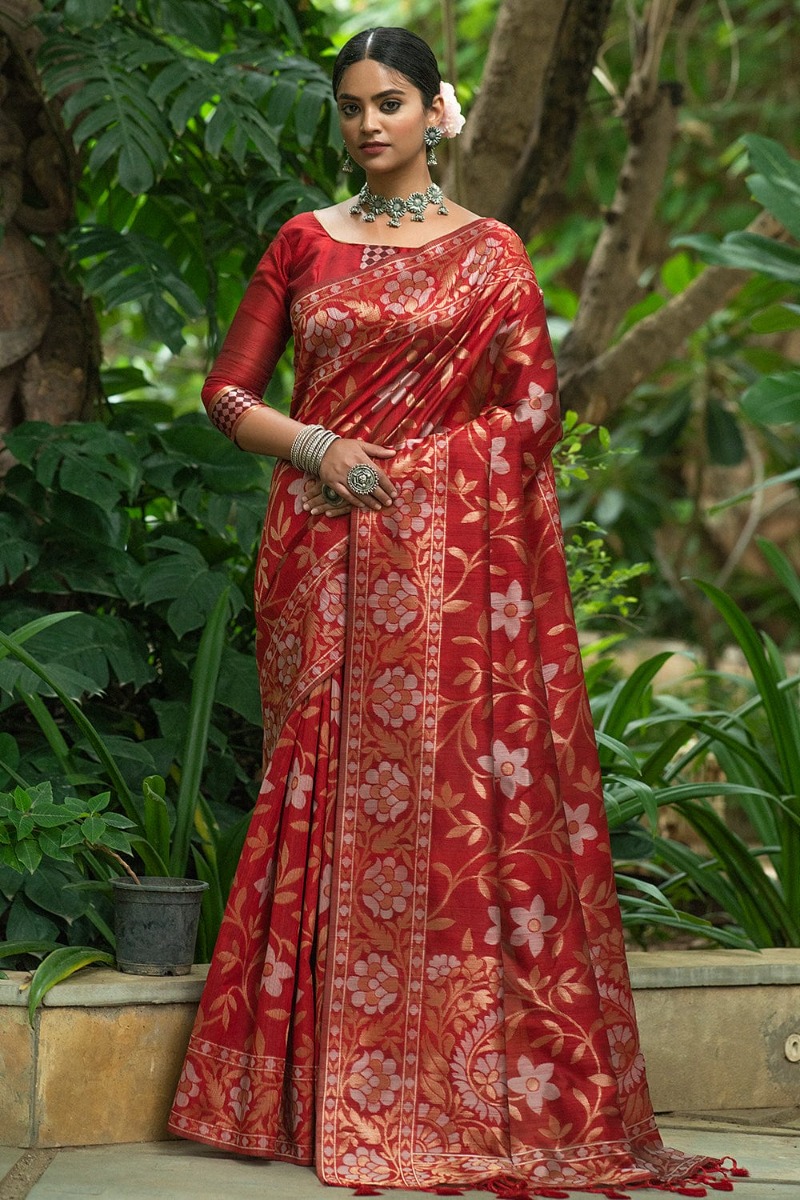
14. Gota Patti Saree from Rajasthan

Pic Courtesy: Pinterest
15. Kota Daria Saree from Rajasthan
Known for their transparent and breathable texture, Kota Doria sarees are comfortable yet stylish, making them a popular choice for warm climates and festive occasions. The hallmark of Kota Doria lies in its distinctive square-shaped weave, called 'khat.'16. Kasavu Saree from Kerala
People often wear Kerala sarees on auspicious occasions, festivals, and cultural events. Artisans craft these sarees from fine cotton and adorn them with an elegant gold border known as kasavu. The pristine white backdrop of the saree symbolises purity and simplicity, while the gold border adds a touch of opulence.
17. Assam Silk Sarees
The durability and resilience of these sarees make them suitable for both formal and festive occasions. Woven from indigenous Assam silk, such as Muga and Eri, these sarees boast a unique lustre that only improves with time.18. Chanderi Sarees from Madhya Pradesh
19. Samudrika Pattu Sarees from Andhra Pradesh
What sets Samudrika Pattu sarees apart is their elaborate zari work, often depicting traditional motifs and mythological themes. They are woven using pure silk threads and the fabric adds a natural sheen. Vibrant hues contribute to the regal appeal.20. Mashru Sarees from Gujarat
21. Jamdani Sarees from West Bengal
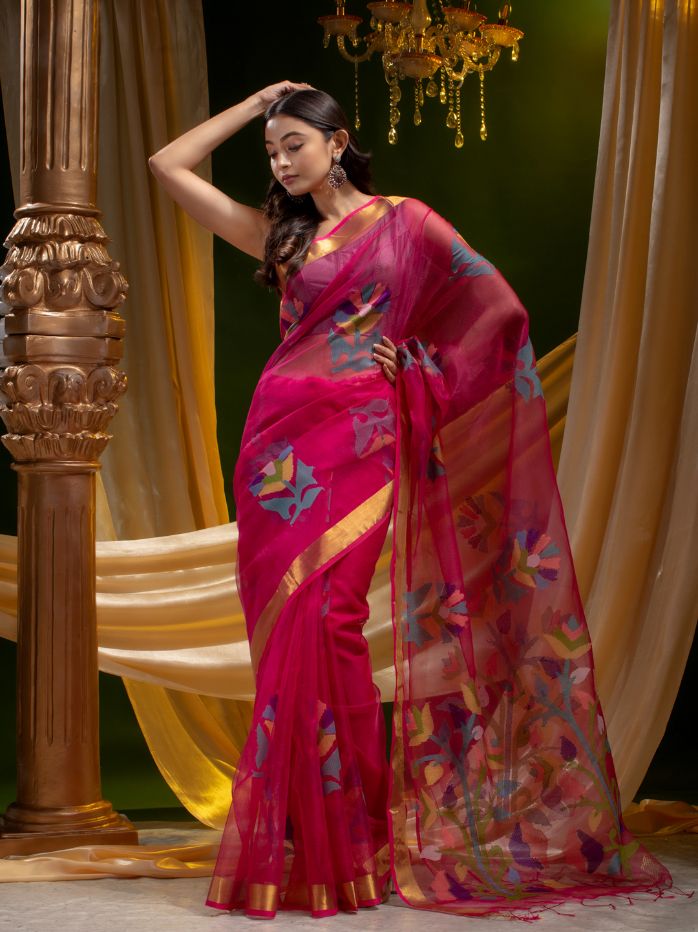
22. Ikkat Sarees from Odisha
Resist-dyeing the yarns before weaving creates the intricate patterns of Ikkat sarees, resulting in geometric designs. With their rich cultural heritage and eye-catching aesthetics, these sarees stand as timeless expressions of skilled craftsmanship.23. Venkatagiri Sarees from Andhra Pradesh
24. Taant Sarees from West Bengal
With their cultural significance and ease of wear, Taant sarees embody the traditional charm and practicality of West Bengal's weaving heritage. The simplicity of the design and the breathable fabric make them a staple in every Bengali woman's wardrobe.25. Santali Sarees of Odisha
Originating from the tribal regions of West Bengal, Jharkhand, and Odisha, these sarees feature bold geometric patterns and bright colours.
26. Patola Sarees from Gujarat
Renowned for their double ikat weave, these sarees involve a meticulous process of resist dyeing both the warp and weft threads before weaving. They are the pinnacle of textile artistry.
27. Kashmiri Saree
The beauty of Kashmiri sarees(Pashmina Sarees) lies in their intricate hand embroidery, often showcasing traditional Kashmiri motifs such as Chinar leaves, paisley patterns (boteh), and floral designs.28. Narayanpet Sarees of Telangana
The weaving tradition in Narayanpet dates back centuries, and the sarees produced here are known for their unique check patterns, contrasting borders, and vibrant colour combinations.29. Baluchari Sarees of West Bengal
Baluchari sarees are known for their vibrant colours, intricate patterns, and a stark contrast between the body and border. The weavers use fine silk threads to create the intricate designs through the Jacquard weaving process.30. Uppada Saree from Andhra Pradesh
Uppada sarees are favoured for both casual and formal occasions, and their timeless appeal and craftsmanship make them highly prized in the world of Indian hand-woven textiles. The distinguishing feature of these sarees is the elaborate zari work on the borders and pallu.31. Gadwal Sarees of Telangana
One of the most peculiar features of the sarees is the“ kuttu” technique, where the silk and cotton are interwoven into a harmonious drape. Gadwal Sarees are celebrated for their unique blend of silk and cotton, creating a luxurious fabric.32. Coorgi Sarees of Karnataka
Crafted from pure silk, they are characterised by bold colours and are often said to be inspired by the lush landscapes and floral abundance of the region. They usually feature motifs like elephants, peacocks, and temple structures.
33. Chikankari Sarees from Lucknow
Wearing a Chikankari saree is not just a style statement; it's embracing a legacy of artistry that dates back centuries. Crafted on fine muslin or cotton fabric, Chikankari sarees feature intricate white threadwork, creating delicate patterns and motifs such as paisleys, floral, and vines.
34. Mangalagiri Sarees of Andhra Pradesh
The hallmark of Mangalagiri sarees is the Nizam border, which is a distinctive feature that consists of a solid-coloured border with a contrasting pattern. Its fabric is known for its rich texture and comfort of wear.35. Pashmina Sarees of Jammu and Kashmir
Pashmina Sarees, embodying luxurious warmth and ageless grace, they are symbols of opulence and traditional artistry. They are soft, feel light-weighted, and hold matchless sophistication.
36. Bomkai Sarees from Odisha
Also known as Sonepuri sarees, these hand-woven pieces of clothing are characterised by their unique meld of intricate ikat patterns and vibrant threadwork. The distinctive characteristic of Bomkai sarees lies in the incorporation of traditional motifs like flowers, animals, and temple designs.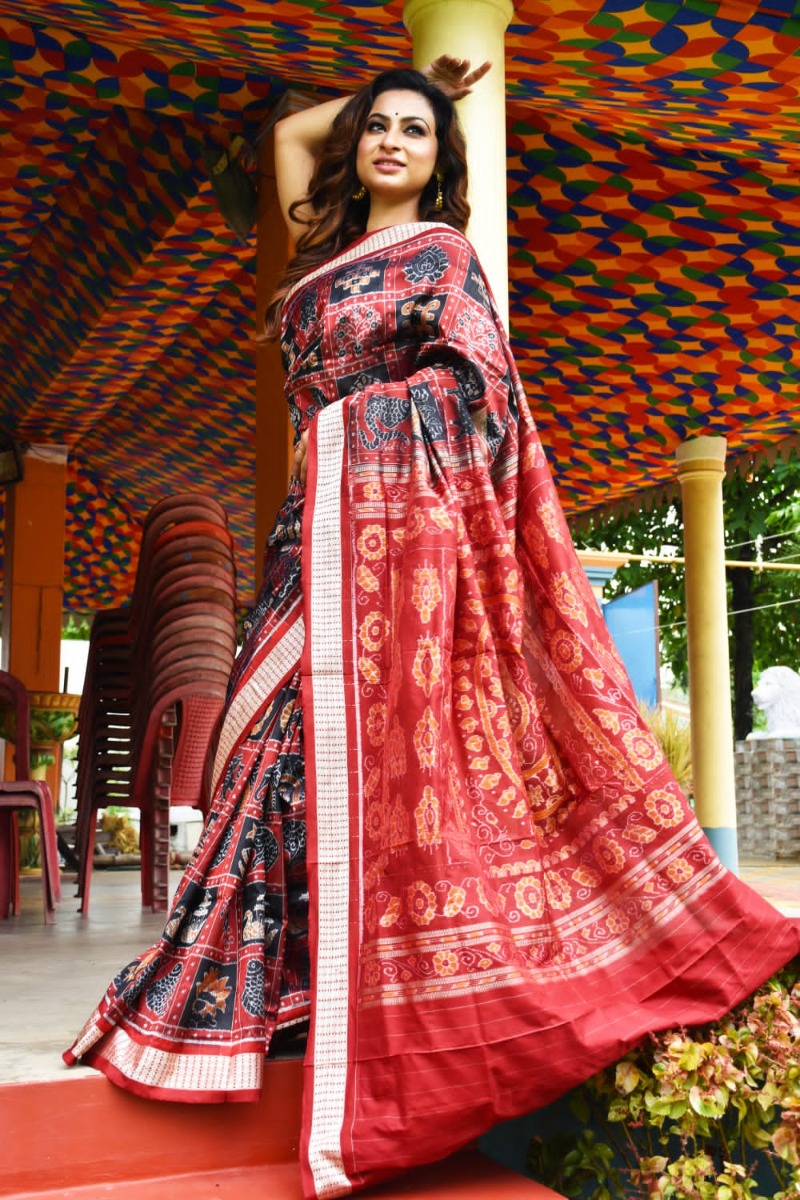
37. Pochampilly Sarees of Telangana
Craftsmen create intricate designs on both the warp and weft threads of these handwoven ikat sarees using a tie-and-dye technique before weaving. Pochampilly sarees often feature traditional motifs like flowers, parrots, and diamonds, reflecting the skilled artwork.38. Chettinad Sarees from Tamil Nadu
They are known for their distinctive checked or striped patterns and vibrant colour combinations. Chettinad sarees are also popularly adored for their durability, comfort, and colour combinations.39. Pattu Saree
Also known as silk sarees, they are frequently chosen for weddings, festivities, and other celebratory occasions. Lustrous texture, intricate zari work, and, of course, the myriad of colours they come in, all make Pattu sarees an excellent option for multiple occasions.
40. Ikkal Sarees from Karnataka
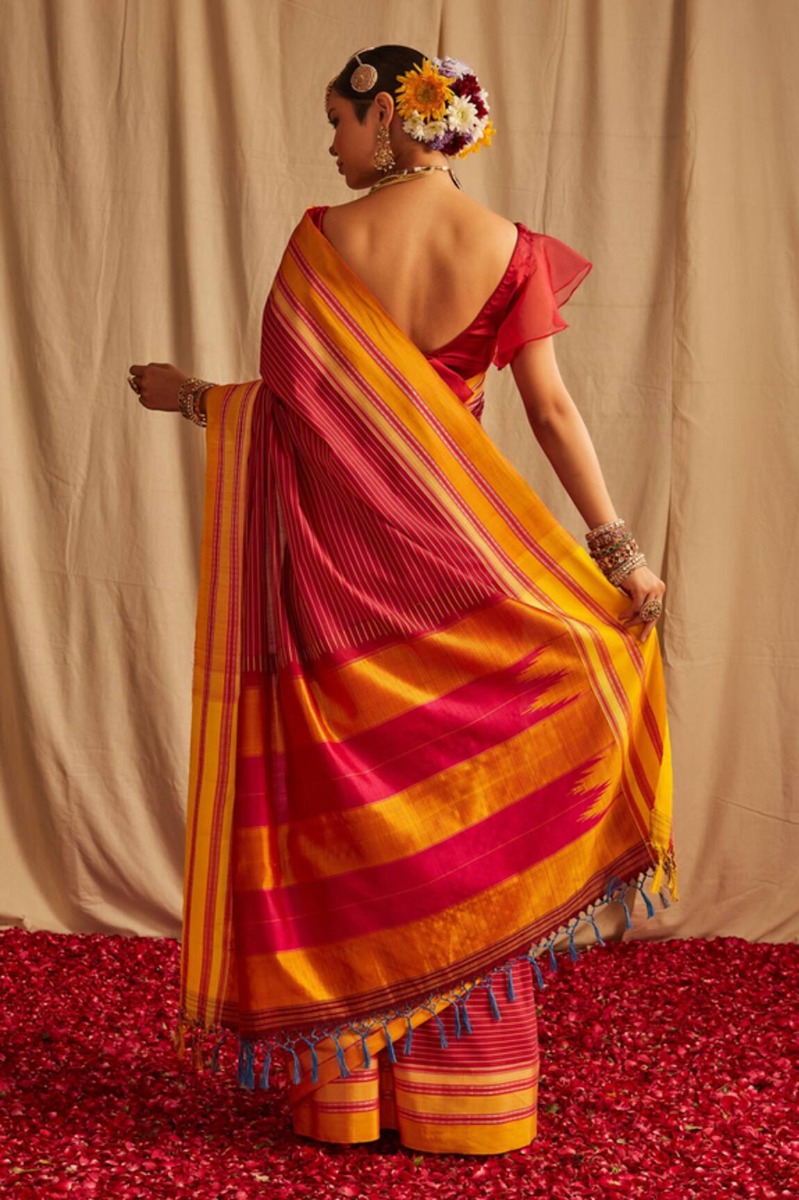
A Glorious Ode to the 40 Threads of India's Textile Heritage
As we draw the curtains on delving into 40 gorgeous saree types, we find ourselves immersed in the beauty and cultural significance that these fabrics reflect. Each fold tells a tale, and every thread weaves a narrative of tradition, artistry, and heritage. We hope you enjoy draping and celebrating the living legacy of Indian textiles.
